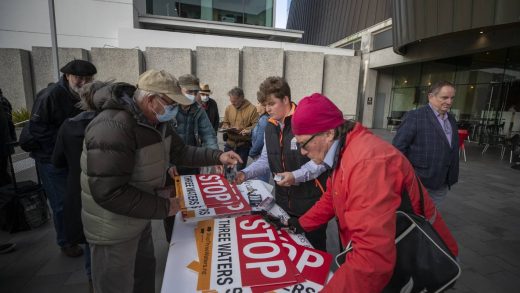![]()
‘Casey and Diana’
By Nick Green, directed by Andrew Kushnir. Until June 17 at Stratford’s Studio Theatre, 34 George St. E., Stratford. Stratfest.com and 800-567-1600.
On Oct. 25, 1991, Princess Diana visited the pioneering HIV/AIDS hospice Casey House in Toronto, and shook the hand of a man living with HIV. After the media left she reportedly spent time with all dozen or so Casey House residents and its staff, and her lack of fear in touching an HIV/AIDS patient without gloves was enormously influential in challenging stigma about the disease.
In these events Nick Green found the seeds for an incredibly moving and deeply accomplished play, having its world premiere in a too-short three-week run at the Stratford Festival, which commissioned the script. If there is justice, Toronto and New York-based producers will stampede to Stratford’s Studio Theatre and extend the life of a play that deeply honours the experiences of gay men at the end of their lives and the people who care for them.
If you’ve wondering how this subject matter could be handled without getting stuck in sentimentality, and if in the era of “The Crown” we really need another Diana-the-icon story, think again.
Green, director Andrew Kushnir, and an impeccable six-person cast have crafted a play and production that invites profound emotional response through restraint, thoughtfulness, and — believe it or not — considerable humour.
The play is set inside Casey House (with care and precision that typifies this production, Joshua Quinlan’s set design includes recreation of its signature leaded glass windows) in the week leading up to Diana’s historic visit. Thomas (Sean Arbuckle), a huge Diana fan, is the longest-lived resident of the house and was losing the capacity to cope. “I hadn’t planned on being here next week,” he tells the steely nurse Vera (Sophia Walker).
The visit gives Thomas and the rest of the Casey community that most life-giving of commodities: Hope. “Princess freaking Diana — that’ll make any homo smile,” he says. And the repeated refrain “we are going to make it” is not a metaphor: Thomas and others, including his vulnerable young roommate Andre (Davinder Malhi) are literally trying to hold on to life long enough to be there for the visit.
Among Green’s many genius strokes are the way he has crafted Diana’s character. It’s hard to discuss without giving too much away, but the extent to which she is both real and not real is a superb theatrical device that embraces the way in which Diana was a real human being who continues to be larger-than-life. With expert help from Quinlan’s costuming and the festival’s wig department, Krystin Pellerin has an uncanny resemblance to the Princess and captures her signature physicality: the tilted head, the simultaneous gangliness and elegance of her willowy limbs.
The laughs come in large part from Green’s beautifully observed writing and Sean Arbuckle’s brilliant playing of Thomas, who crafted an identity around being the one with the zinger lines, be they quotes from “Steel Magnolias” or withering putdowns of the over-invested volunteer Marjorie (Linda Kash), who can give as good as she gets.
But the humour and the pathos come from more than witty exchanges. Each of the six characters is written with complexity and compassion: They’re all imperfect people stumbling their way through unthinkably challenging situations, and sometimes their mistakes and misunderstandings are quietly funny. The final character is Thomas’s initially estranged sister Pauline (Laura Condlln), who’s initially unlikeable but unfurls as we discover just how much the epidemic took out of her as a friend to her brother’s now-decimated circle of gay friends.
As Kushnir writes in a program note, the antagonist in the play is not AIDS. Rather, the play is a subtle but powerful critique of societal neglect and shaming of those with outsider status. It centres Casey House as a place that defied such othering by giving safe haven to those who had nowhere else to go. “We are here to help men with AIDS. We are here to help them die,” says Vera in a late-play speech that both opens up the character’s toughness and drills down on what the play is exploring. “It is a huge gift to give, and it is enough,” she says.
Heartbreaking? Oh my goodness. I have never been in a theatre where an audience gave over so completely to emotion. At some points sobs and sniffles competed with Debashis Sinha’s beautifully sensitive sound design which, echoing the play, makes Casey House into an animate being that contains a sound like hope: “It’s a faint, warm ringing in your ears,” as Diana puts it.
Heartbreaking but also deeply resonant, consoling, and a call to action. For those who lost friends and loved ones to AIDS, it will strike deep (there is a quiet reflection room next to the theatre with a lovely display of some of Casey House’s AIDS quilts). But it is also likely to resonate with anyone who’s nursed someone next to a hospital bed, and with us all as we reflect on the past three years of unconscionable loss and the fact that HIV/AIDS is still rampant in the Global South.
Green has been working on this play for six years and it stands as a testament to how time, resources, and craft (the dramaturge is Bob White) are vital to the creation of great drama. The production elevates Green and Kushnir’s reputations to the next level and again, I greatly hope that it will transfer to Toronto and beyond because many more people deserve to see it.
Stratford opening week already has me wrung out from laughing with “Spamalot” and feeling deeply with “Casey and Diana” — and we’ve not even gotten to the very different AIDS-era story, the musical “Rent,” yet. Keep it coming, Stratford. This is the good stuff.
JOIN THE CONVERSATION
does not endorse these opinions.



